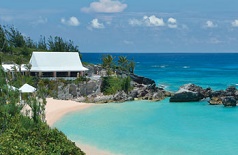 TORONTO—Fairmont Hotels & Resorts announced that it has achieved World Wildlife Fund (WWF) Climate Savers Program targets, reducing its operational CO2 emissions by 20 percent below 2006 levels. In doing so, the luxury hotel brand known for its industry leading sustainability programming becomes the first hotel brand to meet this ambitious environmental goal.
TORONTO—Fairmont Hotels & Resorts announced that it has achieved World Wildlife Fund (WWF) Climate Savers Program targets, reducing its operational CO2 emissions by 20 percent below 2006 levels. In doing so, the luxury hotel brand known for its industry leading sustainability programming becomes the first hotel brand to meet this ambitious environmental goal.
WWF’s Climate Savers Program was designed to inspire companies to change their thinking about climate solutions, while also encouraging them to transform themselves into low-carbon leaders. This leaves member companies better placed to avoid carbon-related risks while realizing opportunities within their long-term business strategies. Fairmont joined Fortune 500 companies and other top businesses like The Coca-Cola Co., Johnson & Johnson, and Nike to develop practical, cost-effective strategies that reduce emissions of CO2 and achieve energy efficiency solutions.
“According to the United Nations, emissions generated directly from the tourism sector account today for 5 percent of global CO2 emissions but may be higher,” said Jane Mackie, Vice President, Fairmont Brand. “When Fairmont joined WWF’s Climate Savers Program in 2009, our mandate was to help address this issue as part of our long standing commitment to sustainability. Achieving this goal is a testament to our colleagues’ commitment to their local communities. Thanks to their hard work, and through the purchase of Renewable Energy Certificates, we have removed as much CO2 as is generated by 13,569 passenger vehicles.”
Industry Innovator with Green Partnership Program
Since its founding over a century ago, Fairmont has worked to deepen its connection to the environment and communities where it conducts business. This mindset led to the launch of the highly acclaimed and industry-leading Green Partnership Program, now known as the Fairmont Sustainability Partnership, a comprehensive approach to reducing the company’s impact on the environment, and to the brand embracing the Climate Savers Program.
“Leading companies like Fairmont are proving that strong environmental action leads to business success,” said Alberto Carrillo, Head of Climate Business Engagement for WWF’s Global Climate and Energy Initiative. “Successful actions like these are critical to mitigating the devastating impacts of climate change on people and nature.”
To meet the Climate Savers agreement, Fairmont undertook a wide variety of initiatives globally, including:
• Reducing operational CO2 emissions by 20 percent below 2006 levels;
• Created and implemented a Green Procurement Policy and Supplier Code of Conduct;
• Educated and encouraged top suppliers (representing approximately 25 percent of the supply chain) to provide products in accordance with the Green Procurement Policy and Supplier Code of Conduct; and
• Updated Design and Construction standards to incorporate and reflect Leadership in Energy & Environmental Design (LEED) standards.
Fairmont hotels around the world also took their own unique approach to the challenge of reducing the brand’s carbon footprint, upgrading infrastructure and changing behaviours to reach the company’s goal. Activities were often driven by the actions of dedicated and passionate colleagues who were, and continue to be, committed to protecting and preserving the environment. Colleagues organized Sustainability Teams, leading the process as proactive, engaged, partners in the program. At the Fairmont St. Andrews, for example, the Sustainability Team hosted open debates and pushed colleagues to propose initiatives that their department could then implement to create savings.
Some other notable activities and initiatives undertaken by Fairmont to achieve its Climate Savers target included:
Europe
• At Fairmont Le Montreux Palace pumping water from Lake Geneva saves more than 60 percent of annual electricity consumption, compared to a standard air-conditioning installation (340,000 kWh/year).
• In London, The Savoy, A Fairmont Managed Hotel, installed a centralized compressor plant for all kitchen walk-in fridges and freezers. The hotel’s refrigeration plant reclaims waste heat to preheat domestic hot water by 5 degrees Celsius. Reclaiming waste heat produces an approximate saving of $59,500 over the course of the year, and reduces the loading and firing rate of the boilers which also extends the expected life of the boiler and reduces maintenance costs.
Middle East, Africa & India
• Using outside breezes instead of air-conditioning to circulate cold air into the Fairmont Dubai during the winter. This reduced energy consumption without impacting guest comfort.
Americas
• Fairmont Orchid, Hawaii heats its pool using waste heat from a chiller system at no cost. If the hotel were to heat its pool using conventional heating methods (like propane) it would cost more than $90,000 per year. The Fairmont Orchid, Hawaii is now examining the potential to apply solar films on windows and panels on the roof of the hotel to generate more of its power from a more sustainable source.
• In the heart of the Canadian Rockies, the Fairmont Banff Springs began utilizing outdoor ambient temperatures for its chilled water system. It estimates that this will save approximately 368,750 kWh of energy consumption annually.
Asia Pacific
• At Fairmont Singapore, the in-house Sustainability Team conducts monthly audits of offices, kitchens, and rooms to ensure energy efficient practices.
“Fairmont was very motivated through our partnership with WWF to help tackle climate change, achieve significant CO2 reductions, and deliver results worldwide,” said Allison Long, Fairmont’s Business Analyst, Environmental Affairs. “We are pleased with the results achieved thanks to our dedicated colleagues and are excited to be the first luxury hotel brand to reach the Climate Savers Program targets.”
Go to Fairmont Hotels & Resorts.






